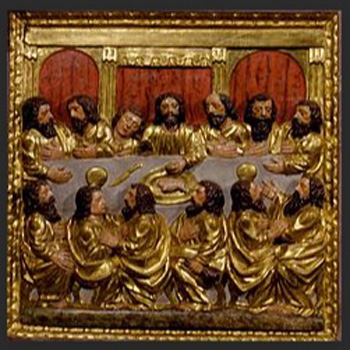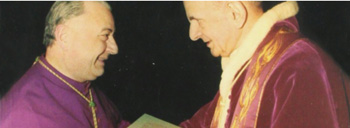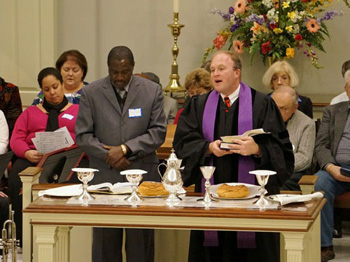Traditionalist Issues
 |
 |
 |
 |
 |
 |
 |
Smell of Heresy in Paul VI’ Mass
Lumen gentium affirms that “the common priesthood of the faithful and the ministerial or hierarchical priesthood are ordered to one another… although they differ in essence and not just in degree, each of them in its own special way is a participation in the one priesthood of Christ.” (LG 10).
But there is also an underlying heterodox meaning in the Second Vatican Council (1962-1965), as explained below.
 The Mass is the reconstruction of the Israelite Passover meal of the Old Testament (1), a ceremony commemorating the day that God had delivered the Israelites out of their slavery in Egypt The Passion and Death of the Messiah are the New Passover of the New Covenant by which the faithful are saved from their bondage to sin and enter new the promised land, the Catholic Church which leads them to eternal salvation, Heaven.
The Mass is the reconstruction of the Israelite Passover meal of the Old Testament (1), a ceremony commemorating the day that God had delivered the Israelites out of their slavery in Egypt The Passion and Death of the Messiah are the New Passover of the New Covenant by which the faithful are saved from their bondage to sin and enter new the promised land, the Catholic Church which leads them to eternal salvation, Heaven.
In consecrating the bread and the chalice at the Last Supper and directing His Apostles to repeat this act as a memorial of the Sacrifice of the Cross, Our Lord established the celebration of the Holy Mass as the New Passover.
According to the traditional teaching of the Church, the Sacrifice is made only by one priest.
Now, according to the Council, this concept changed: It is an assembly of baptized people - presided over by a qualified Church official - that remembers the birth, life, passion, death and resurrection of Jesus Christ.
The Mass was transformed. Now it is a liturgical-eucharistic “meal” (I Cor. 11, 21) in which it is the community that celebrates. There isa nuclear difference between the Lumen gentium common priesthood of the faithful and the traditional idea that only a member of the clergy can celebrate the Mass.
Such contestation is expressed in the Reformed Mass of Msgr. Anibal Bugnini and his Lutheran Carthaginians, following the orientation of the Constitution “Sacrosanctum Concilium” on the liturgy (2). The Mass that issued from it was made official on November 30, 1969 by Paul VI in his address to a general audience on the Ordo Missae.
 The ambiguities in the text of Sacrosanctum Concilium that are at the root of this contestation were pointed out by the incomparable conciliar scholar Atila Sinke Guimarães:
The ambiguities in the text of Sacrosanctum Concilium that are at the root of this contestation were pointed out by the incomparable conciliar scholar Atila Sinke Guimarães:
“Once again, the disastrous results are evident regarding the ambiguities of the texts of the Constitution Sacrosanctum Concilium, as well as the liturgical reform and the documents of 1969-1970 concerning the Mass.” (3).
In a cautious one line summary, the progressivist Franciscan theologian Boaventura Kloppenburg recognized that the Council of John XXIII and Paul VI insinuated the idea of an ecclesial equality between the clergy and the laity: “The theology of the layman seems to have placed the theology of the priest in crisis.” This is a notoriously hypertrophied conception of the “common priesthood” of the faithful (4).
In 1993,the future German Cardinal Walter Kasper confirmed this progressivist interpretation:
“The crisis of the priesthood in the Catholic Church has multiple causes … At the depth of this crisis we undoubtedly find the accentuation of the ecclesiology of the people of God, carried out by Vatican Council II itself, which clearly shows the reality of the common priesthood of all the baptized. Excessive value was given to the specific vocation of lay Christians.” (5)
This ecclesiastical deformation resulted in new concepts such as the“concelebration with the people,” who before were consider as spectators” without he right of “full, conscious and active participation” (SC, 54, 48, 14).
Indeed, the orthodox liturgy, respectful silence, dignified ways of acting and dressing tendentially led the people to understand the mysteries of the liturgy.
In the Roman Missal, the translation from the Latin language and the numerous explanatory notes provide only a purely intellectual understanding of what was taking place.
At first, an acolyte, a layman - representing the people - responded to the celebrant (6); later participatory responses were made by the whole congregation, to which a collective confession of the laymen was added. (7)
Yesterday, the priest stood between the crucifix/tabernacle and the laity, symbolically affirming that he was an accredited authority and representative of God.
Today, he turns to the people, insinuating that the priestly primacy is a sociological dignity and he is a mere representative of the community.
The smell of heresy
Thus came into being the continual dialogue of the two parties: The laity read the Gospel, preach the homily, distribute communion, place the host in their mouths as if they were the priest.
The reminiscent, narrative and commemorative notes of the ancient “paschal banquet” (SC) of yesteryear were accentuated in the new liturgy, methodically suggesting that the Mass is, purely and simply, a Christian religious memorial meal.
In final analysis, the vague spiritual meal on the emphasized "table of God" (SC, 51 – paragraph 605) served to seal “the encounter with Christ,” without reference to the sacrificial character of the Mass.
 In this context, it makes no sense for the principal guest the banquet to have his back to the other feasters; further it would be illogical and extravagant for a guest to fast and inexplicable to enjoy the meal while kneeling, in accordance with the beautiful tradition that preceded the Second Vatican Council.
In this context, it makes no sense for the principal guest the banquet to have his back to the other feasters; further it would be illogical and extravagant for a guest to fast and inexplicable to enjoy the meal while kneeling, in accordance with the beautiful tradition that preceded the Second Vatican Council.
This process of the Protestantization of the Mass was clearly reflected in the five data that follow:
In short, today the celebrant of the Mass has become nothing more than the minister who is part of the common priesthood.
But there is also an underlying heterodox meaning in the Second Vatican Council (1962-1965), as explained below.

The Last Supper was made in the feast
of the Jewish Passover
In consecrating the bread and the chalice at the Last Supper and directing His Apostles to repeat this act as a memorial of the Sacrifice of the Cross, Our Lord established the celebration of the Holy Mass as the New Passover.
According to the traditional teaching of the Church, the Sacrifice is made only by one priest.
Now, according to the Council, this concept changed: It is an assembly of baptized people - presided over by a qualified Church official - that remembers the birth, life, passion, death and resurrection of Jesus Christ.
The Mass was transformed. Now it is a liturgical-eucharistic “meal” (I Cor. 11, 21) in which it is the community that celebrates. There isa nuclear difference between the Lumen gentium common priesthood of the faithful and the traditional idea that only a member of the clergy can celebrate the Mass.
Such contestation is expressed in the Reformed Mass of Msgr. Anibal Bugnini and his Lutheran Carthaginians, following the orientation of the Constitution “Sacrosanctum Concilium” on the liturgy (2). The Mass that issued from it was made official on November 30, 1969 by Paul VI in his address to a general audience on the Ordo Missae.

Msgr. Annibale Bugnini with Paul VI, the two master-minds of the New Mass
“Once again, the disastrous results are evident regarding the ambiguities of the texts of the Constitution Sacrosanctum Concilium, as well as the liturgical reform and the documents of 1969-1970 concerning the Mass.” (3).
In a cautious one line summary, the progressivist Franciscan theologian Boaventura Kloppenburg recognized that the Council of John XXIII and Paul VI insinuated the idea of an ecclesial equality between the clergy and the laity: “The theology of the layman seems to have placed the theology of the priest in crisis.” This is a notoriously hypertrophied conception of the “common priesthood” of the faithful (4).
In 1993,the future German Cardinal Walter Kasper confirmed this progressivist interpretation:
“The crisis of the priesthood in the Catholic Church has multiple causes … At the depth of this crisis we undoubtedly find the accentuation of the ecclesiology of the people of God, carried out by Vatican Council II itself, which clearly shows the reality of the common priesthood of all the baptized. Excessive value was given to the specific vocation of lay Christians.” (5)
This ecclesiastical deformation resulted in new concepts such as the“concelebration with the people,” who before were consider as spectators” without he right of “full, conscious and active participation” (SC, 54, 48, 14).
Indeed, the orthodox liturgy, respectful silence, dignified ways of acting and dressing tendentially led the people to understand the mysteries of the liturgy.
In the Roman Missal, the translation from the Latin language and the numerous explanatory notes provide only a purely intellectual understanding of what was taking place.
At first, an acolyte, a layman - representing the people - responded to the celebrant (6); later participatory responses were made by the whole congregation, to which a collective confession of the laymen was added. (7)
Yesterday, the priest stood between the crucifix/tabernacle and the laity, symbolically affirming that he was an accredited authority and representative of God.
Today, he turns to the people, insinuating that the priestly primacy is a sociological dignity and he is a mere representative of the community.
The smell of heresy
Thus came into being the continual dialogue of the two parties: The laity read the Gospel, preach the homily, distribute communion, place the host in their mouths as if they were the priest.
The reminiscent, narrative and commemorative notes of the ancient “paschal banquet” (SC) of yesteryear were accentuated in the new liturgy, methodically suggesting that the Mass is, purely and simply, a Christian religious memorial meal.
In final analysis, the vague spiritual meal on the emphasized "table of God" (SC, 51 – paragraph 605) served to seal “the encounter with Christ,” without reference to the sacrificial character of the Mass.

The Novus Ordo Mass was modeled after the Protestant service, above
This process of the Protestantization of the Mass was clearly reflected in the five data that follow:
- Dispensing with the title “Saint” when referring to the Evangelists, (8) based on the Dogmatic Constitution Dei Verbum (DV, 18);
- The priest's vestments became similar to those of the Protestant “pastor”;
- The past splendor of the liturgy was impoverished to favor the Protestant egalitarian spirit;
- From this came the “encouraging the acclamations of the people” and the new egalitarian “gestures and bearing of the body” (SC, 30);
- A gathering with a “worldly” character (9), to speak about parish and social events, contrary to the vigilance taught in the past (I Jo. 5:19; Ap 21: 27) and endorsed by the bimillennial Catholic moral literature.
In short, today the celebrant of the Mass has become nothing more than the minister who is part of the common priesthood.
- 1. “É o sacrifício da Páscoa, em honra do Senhor” (Ex. 12:27).
- 2. 3. 5. 9. Atila Sinke Guimaraes, Nas águas turvas do Concílio Vaticano II, São Paulo: Scor Editora Tecci, 1999, vol. I, pp. 184-186, 249, 305, 262.
- 4. A Eclesiologia do Vaticano II, Petrópolis: Vozes, 1971, p. 53.
- 6. 7. 8. Dom Beda Keckeisen, OSB. Missal Cotidiano, Salvador: Tipografia Beneditina Ltda., 1949, pp. 1, 3, 29.
Posted December 2, 2022

______________________
______________________
 Volume I |
 Volume II |
 Volume III |
 Volume IV |
 Volume V |
 Volume VI |
 Volume VII |
 Volume VIII |
 Volume IX |
 Volume X |
 Volume XI |
 Special Edition |